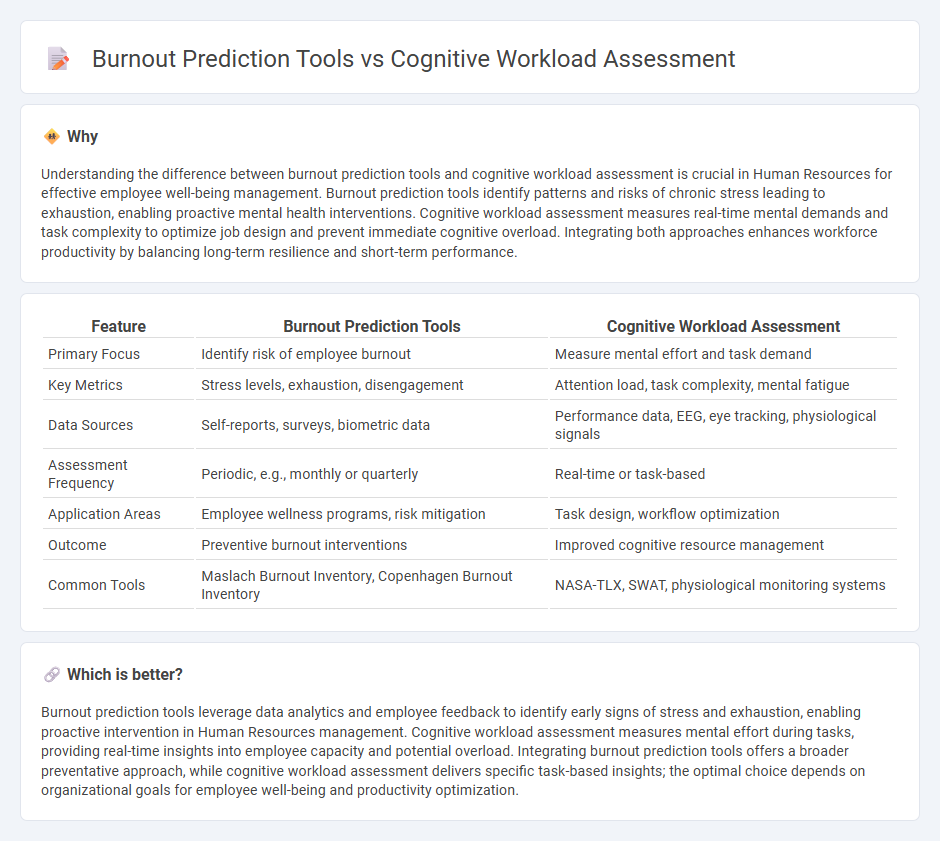
Burnout prediction tools analyze employee data such as work hours, stress levels, and productivity patterns to identify early signs of exhaustion and disengagement. Cognitive workload assessment measures mental effort and task complexity through physiological indicators and performance metrics to evaluate employee capacity in real-time. Explore the latest advancements in these human resources technologies to enhance workforce well-being and efficiency.
Why it is important
Understanding the difference between burnout prediction tools and cognitive workload assessment is crucial in Human Resources for effective employee well-being management. Burnout prediction tools identify patterns and risks of chronic stress leading to exhaustion, enabling proactive mental health interventions. Cognitive workload assessment measures real-time mental demands and task complexity to optimize job design and prevent immediate cognitive overload. Integrating both approaches enhances workforce productivity by balancing long-term resilience and short-term performance.
Comparison Table
| Feature | Burnout Prediction Tools | Cognitive Workload Assessment |
|---|---|---|
| Primary Focus | Identify risk of employee burnout | Measure mental effort and task demand |
| Key Metrics | Stress levels, exhaustion, disengagement | Attention load, task complexity, mental fatigue |
| Data Sources | Self-reports, surveys, biometric data | Performance data, EEG, eye tracking, physiological signals |
| Assessment Frequency | Periodic, e.g., monthly or quarterly | Real-time or task-based |
| Application Areas | Employee wellness programs, risk mitigation | Task design, workflow optimization |
| Outcome | Preventive burnout interventions | Improved cognitive resource management |
| Common Tools | Maslach Burnout Inventory, Copenhagen Burnout Inventory | NASA-TLX, SWAT, physiological monitoring systems |
Which is better?
Burnout prediction tools leverage data analytics and employee feedback to identify early signs of stress and exhaustion, enabling proactive intervention in Human Resources management. Cognitive workload assessment measures mental effort during tasks, providing real-time insights into employee capacity and potential overload. Integrating burnout prediction tools offers a broader preventative approach, while cognitive workload assessment delivers specific task-based insights; the optimal choice depends on organizational goals for employee well-being and productivity optimization.
Connection
Burnout prediction tools leverage cognitive workload assessment data to identify employees experiencing excessive mental strain, enabling early intervention. These tools analyze patterns in task complexity, time pressure, and multitasking frequency to forecast burnout risks. Integrating cognitive workload metrics enhances the accuracy and responsiveness of human resources strategies to maintain employee well-being and productivity.
Key Terms
**Cognitive Workload Assessment:**
Cognitive workload assessment evaluates mental effort during tasks using metrics like heart rate variability, EEG, and eye tracking to optimize performance and prevent errors. These tools provide real-time data to identify overload, enabling adjustments before fatigue escalates into burnout. Explore advanced cognitive workload solutions to enhance workplace well-being and productivity.
Mental Fatigue
Cognitive workload assessment tools measure mental effort during tasks to detect signs of mental fatigue, while burnout prediction tools analyze long-term psychological stress patterns to forecast chronic exhaustion. Mental fatigue is a common indicator in both approaches, with cognitive workload evaluations providing real-time data and burnout tools offering longitudinal insights. Explore the latest advancements in mental fatigue measurement for enhanced workplace well-being.
Task Complexity
Task complexity significantly influences both cognitive workload assessment and burnout prediction tools by determining the mental effort required to complete tasks and the risk of stress accumulation. Cognitive workload assessment uses metrics like multitasking demands and decision-making difficulty to evaluate immediate mental strain, while burnout prediction models incorporate prolonged exposure to complex tasks to forecast emotional exhaustion and reduced performance. Explore more to understand how task complexity shapes effective strategies for managing cognitive health.
 dowidth.com
dowidth.com